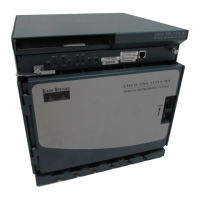
Do you have a question about the Cisco ONS 15310-MA and is the answer not in the manual?
| Manufacturer | Cisco |
|---|---|
| Model | ONS 15310-MA |
| Form Factor | Plug-in module |
| Connectivity Technology | Wired |
| Data Link Protocol | SONET |
| Data Transfer Rate | 2.5 Gbps |
| Supported Interfaces | OC-48, STM-16 |
| Designed For | Cisco ONS 15310-CL, Cisco ONS 15310-MA Chassis |
| Operating Temperature | 0 °C - 50 °C |
| Storage Temperature | -40 °C - 70 °C |
| Humidity | 5% - 95% (non-condensing) |
Lists alarms categorized by their default severity levels (Critical, Major, Minor).
Details critical alarms encountered in the ONS 15310-MA SDH system.
Details major alarms encountered in the ONS 15310-MA SDH system.
Provides an alphabetical listing of all ONS 15310-MA SDH alarms and conditions.
Explains how alarms and conditions are organized by logical objects in the system alarm profile.
Lists ONS 15310-MA SDH alarms and their associated logical objects as per the system alarm profile.
Defines standard Telcordia severities: Critical, Major, Minor, Not Alarmed, Not Reported.
Details the Alarm Indication Signal (AIS) condition, its severity, logical objects, and troubleshooting.
Describes the Battery Fail alarm, its severity, logical object, and troubleshooting steps.
Explains the Primary Nonvolatile Backup Memory Failure alarm, its severity, logical object, and troubleshooting.
Covers the Carrier Loss alarm on CE-Series cards, its severity, logical objects, and troubleshooting.
Explains the Carrier Loss on LAN Equipment alarm, its severity, logical object, and troubleshooting.
Details the Carrier Loss alarm on ML-100T-8 Ethernet cards, its severity, logical objects, and clearing.
Explains the CONTBUS-DISABLED alarm for Ethernet card defects, its severity, logical object, and clearing.
Explains the Interconnection Equipment Failure Protect Cross-Connect Card Payload Bus alarm, its severity, logical object, and troubleshooting.
Covers the data cyclic redundancy check Bad Packet Count alarm, its severity, logical objects, and troubleshooting.
Explains the Extreme High Voltage Battery alarm, its severity, logical object, and troubleshooting.
Details the Extreme Low Voltage Battery alarm, its severity, logical object, and troubleshooting.
Covers the Encapsulation C2 Byte Mismatch Path alarm, its severity, logical objects, and troubleshooting.
Covers the Equipment Failure alarm, its severity, logical objects, and troubleshooting.
Explains the Replaceable Equipment or Unit Missing alarm for the fan tray, its severity, logical object, and clearing.
Covers the Improper Removal equipment alarm, its severity, logical objects, and troubleshooting.
Details the Loss of Alignment on a VCG alarm, its severity, logical object, and troubleshooting.
Details the Sequence Mismatch alarm, its severity, logical objects, and clearing.
Explains the Switching Matrix Module Failure on Protect Slot alarm, its severity, logical object, and troubleshooting.
Covers the Switching Matrix Module Failure on Working Slot alarm, its severity, logical object, and troubleshooting.
Explains the Section TIM alarm due to trace string mismatch, its severity, logical object, and troubleshooting.
Explains the TIM Path alarm due to path trace string mismatch, its severity, logical objects, and troubleshooting.
Covers the TIM for Section Overhead alarm due to string mismatch, its severity, logical objects, and troubleshooting.
Details the Transport Layer Failure alarm for Ethernet link integrity, its severity, logical objects, and troubleshooting.
Details the SLMF UNEQ Path alarm, its severity, logical objects, and troubleshooting.
Details instructions for port and span switching, lock-ons, and lockouts.
Provides procedures for soft or hard resetting Ethernet, electrical, or controller cards in CTC.
